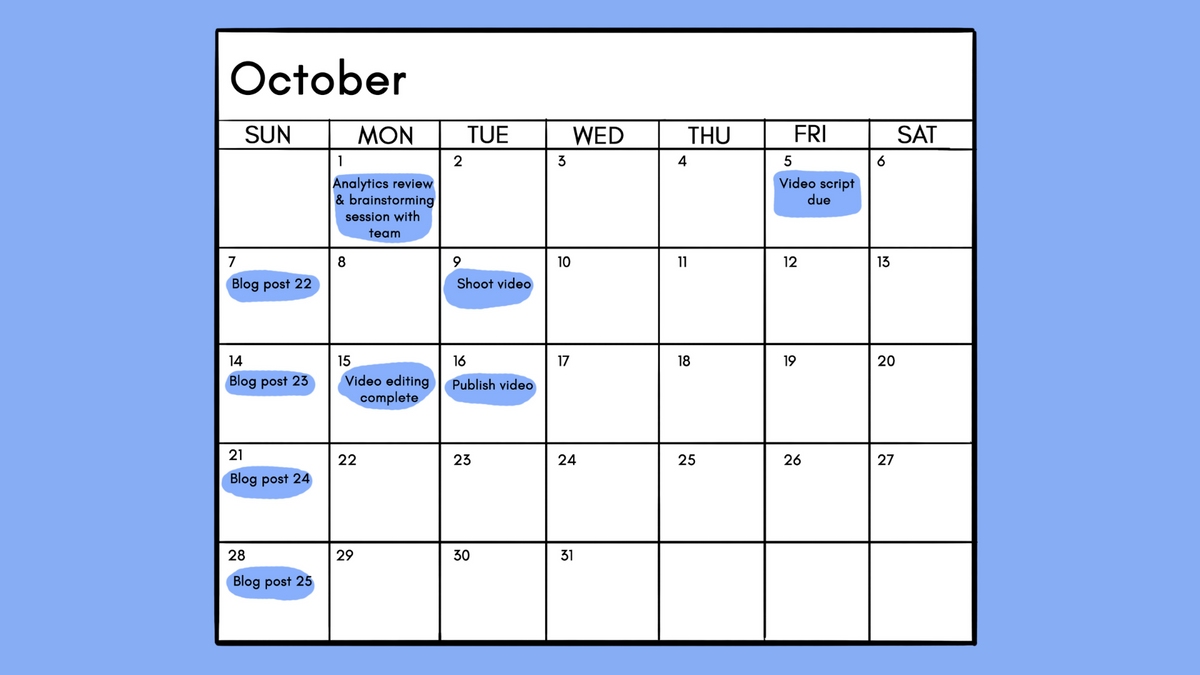Picture this: It's a brand new day and you have absolutely no idea what to post to your brand's social media channels or the blog. You struggle to put something together quickly, but end up doing a half-baked job. Sounds familiar?
Not planning your content in advance can cause a lot of unnecessary anxiety, brand guideline issues, and even lead to typos and other errors in your posts.
A well-set content calendar can help you ensure that you—and other stakeholders like the marketing team, design team and brand heads—know the schedule well in advance. This will help you avoid scrambling for ideas last minute plus allow you to design content for maximum reach.
Sounds like a tall task? Well, not only is creating an effective social media calendar easy, but we're also giving you a FREE content calendar template to help you get started!
But first:
What is a content calendar?
A content calendar is where you map out which piece of brand content you will post on your social media platforms and on what dates. Marketers and content strategists often use physical or online calendars to chart post ideas, manage campaigns and even coordinate with brand assets.
The content calendar is also where your creative ideas will take the shape of various content pieces. For example, if your idea is a productivity hack that you want to share with your audience in just a couple of lines and a GIF, you can decide to post it on Twitter. But if this hack requires a long-form explanation, then it’s best to explain it in a YouTube video, an Instagram reel or a TikTok video. Your content calendar helps transition your idea to actual content pieces, and decide what platform it will be posted on.

The benefits of maintaining content calendars
Sure, planning ahead is a great idea. But why bother with a content calendar when you can still decide on posts at the spur of the moment?
Well, with a content calendar, the most important benefit is that there are no unpleasant surprises. Not only you, but the entire team responsible for working on social media ideas knows exactly what is due and when. This means that everyone also has a clear idea of the content piece being produced, the approximate time needed to get them ready, the resources required to execute the ideas, and even the personnel involved in executing them. Everything is decided beforehand!
The entire scope of content requires the contribution of your entire team—creatives, graphic designers, copywriters, actors, and more, depending on the size and nature of the content your brand produces. Having a well-laid-out content calendar also ensures that everyone knows their role, contribution, and deadlines! Your content calendar eases collaboration efforts with your diverse team as everyone knows what is expected of them well in advance, and can help them plan their workday accordingly.
The content calendar allows the content team to have a bird’s eye view of the content pieces that will be worked on over a week, month, or even a couple of months! This ensures that all the content is aligned with the brand’s overall content strategy and the client’s requirements.
Putting your content ideas on a timeline is a sure-shot way of getting them to your audience! Let’s look at how to create a content calendar that benefits your brand!
Creating a social media calendar
While many brands prefer creating their social media calendars on spreadsheets, you can use actual calendars to create yours. This will not just give you a better visual layout of what pieces are due when, but you can also use the calendar's hourly breakdown sections to minutely pinpoint the time as well.
Sketchnote offers a calendar view for tasks that you can use to build your own brand calendar, add tasks, label them and even assign them to your teammates.
Overview of your content strategy and analytics
Now that you have a calendar in place, let's go back to some basics. The first step of your setting up a content calendar is not planning ahead, but looking back at the content you've put out in the recent past.
Understanding what pieces of content have done well provides you with evidence that that type of content could be posted more often. Set goals and KPI metrics in place—like reach, engagement rate, video views, etc.—that will help you plan your content in the future as well. Creating an overview provides you with the chance to look for gaps and opportunities that you have missed out on previously.
For example, if you find that engagement on your LinkedIn page is low, you can devise strategies to boost it, like posting more often, posting at time slots when your audience is most active on that platform, or employing other content marketing techniques.
This is also a good time to find out if there's a change in the content strategy, goals, target audience, and pivots in the brand that needs to be incorporated into your content calendar.
Details to include in your content calendar
It’s important to set certain checkpoints of details that form part of your content calendar. These checkpoints pertaining to each content idea allows you to have enough details to pitch it for approval, and also provides direction while executing the idea. These may vary depending on the size and nature of content your brand produces, but must always include:
- Type of content—Reel, Twitter/LinkedIn Carousel, Blog post, Tweet, etc.
- Brief description of the content idea
- The date it's to be posted on
- Copy involved—both on the creative and as caption
- Who is the task assigned to? Mark the copy team and the design team
- Visual assets like videos, images, etc.
- Budget details, if required
Getting these details locked in at the onset provides you with a north star while executing these ideas.

Maintaining an idea log
The best part about maintaining a content calendar is that it lets you ideate and turn concepts into posts well in time. But not all ideas can be accommodated into a calendar immediately!
Many brands prefer working a month in advance—by planning posts for the upcoming month in the present one. And if coming up with creative ideas is your forte, create an idea log and maintain a bank.
Fire up a document on the content calendar file inside Sketchnote, and dump all the ideas that can be turned into useable posts for your brand in the future. It could be something as simple as a witty one-liner for Twitter, a meme idea, a current-affair event that can be used for a blog post, or a how-to reel—pretty much anything goes!
Making this idea log available to the rest of your team also allows them to pitch in, creating a pool of ideas to choose from. Asynchronously adding ideas is a great way to prepare a treasure trove of potential content pieces, whenever the time is right.
Getting approvals and feedback
Once you have fit your amazing content ideas on a calendar, it’s time to get them approved! The idea behind creating a content calendar is that everyone in the content team knows what is to be executed and within what timeframe. It's, therefore, critical that all the ideas are approved well before the date of posting, so that the team can allot themselves the time required to make the content pieces.
Ensure you have enough time at hand to receive feedback and make the relevant changes necessary too. Getting feedback can be a bit daunting at times, but when you work towards a common goal of doing what's best for the brand, you align better with all stakeholders.
Get started with a content calendar template
Creating content is time-sensitive as well as time-consuming! So, it's essential that the team gets the planning right. Using a Content calendar template like the one in Sketchnote’s Template store, allows your content team and design teams to stay on top of completion status. At every stage, the task status can be updated for teammates to know detailed content ideas for execution and completion deadlines.
Once the perfect content calendar is drawn up, it’s now all stakeholders' responsibility to adhere to it.
Remember certain rules here though:
- Always be doubly sure of the content posting, so there's no scope for error.
- Bear in mind that no plan is set in stone. There could be immediate events that may influence your posts, so always account for it.
- Many times content creators can fall prey to the idea that new ideas may not be accepted. Push your boundaries slowly but steadily to experiment with innovations.
Stick to your calendar as much as possible to see the most optimal results your content can bring!



